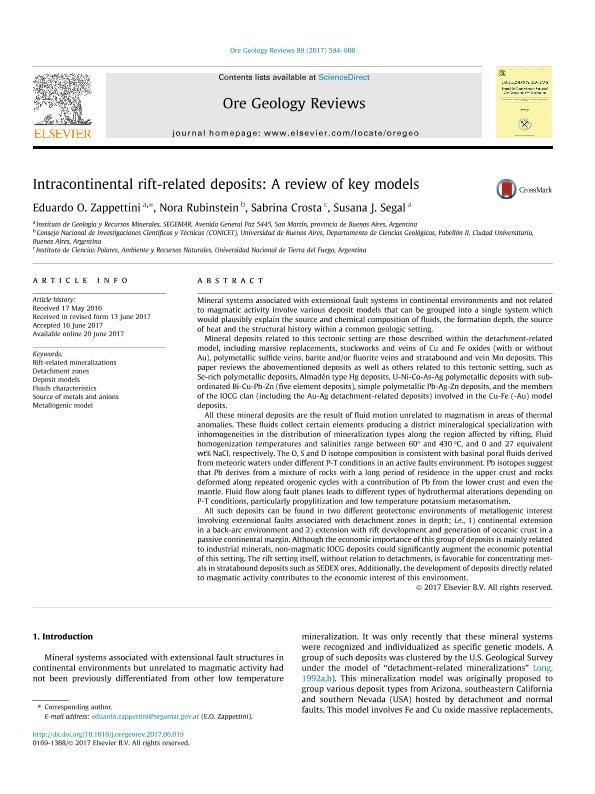Mostrar el registro sencillo del ítem
dc.contributor.author
Zappettini, Eduardo Osvaldo

dc.contributor.author
Rubinstein, Nora Alicia

dc.contributor.author
Crosta, Sabrina
dc.contributor.author
Segal, Susana J.
dc.date.available
2018-11-28T17:58:44Z
dc.date.issued
2017-10
dc.identifier.citation
Zappettini, Eduardo Osvaldo; Rubinstein, Nora Alicia; Crosta, Sabrina; Segal, Susana J.; Intracontinental rift-related deposits: A review of key models; Elsevier Science; Ore Geology Reviews; 89; 10-2017; 594-608
dc.identifier.issn
0169-1368
dc.identifier.uri
http://hdl.handle.net/11336/65468
dc.description.abstract
Mineral systems associated with extensional fault systems in continental environments and not related to magmatic activity involve various deposit models that can be grouped into a single system which would plausibly explain the source and chemical composition of fluids, the formation depth, the source of heat and the structural history within a common geologic setting. Mineral deposits related to this tectonic setting are those described within the detachment-related model, including massive replacements, stockworks and veins of Cu and Fe oxides (with or without Au), polymetallic sulfide veins, barite and/or fluorite veins and stratabound and vein Mn deposits. This paper reviews the abovementioned deposits as well as others related to this tectonic setting, such as Se-rich polymetallic deposits, Almadén type Hg deposits, U-Ni-Co-As-Ag polymetallic deposits with subordinated Bi-Cu-Pb-Zn (five element deposits), simple polymetallic Pb-Ag-Zn deposits, and the members of the IOCG clan (including the Au-Ag detachment-related deposits) involved in the Cu-Fe (-Au) model deposits. All these mineral deposits are the result of fluid motion unrelated to magmatism in areas of thermal anomalies. These fluids collect certain elements producing a district mineralogical specialization with inhomogeneities in the distribution of mineralization types along the region affected by rifting. Fluid homogenization temperatures and salinities range between 60° and 430 °C, and 0 and 27 equivalent wt% NaCl, respectively. The O, S and D isotope composition is consistent with basinal poral fluids derived from meteoric waters under different P-T conditions in an active faults environment. Pb isotopes suggest that Pb derives from a mixture of rocks with a long period of residence in the upper crust and rocks deformed along repeated orogenic cycles with a contribution of Pb from the lower crust and even the mantle. Fluid flow along fault planes leads to different types of hydrothermal alterations depending on P-T conditions, particularly propylitization and low temperature potassium metasomatism. All such deposits can be found in two different geotectonic environments of metallogenic interest involving extensional faults associated with detachment zones in depth; i.e., 1) continental extension in a back-arc environment and 2) extension with rift development and generation of oceanic crust in a passive continental margin. Although the economic importance of this group of deposits is mainly related to industrial minerals, non-magmatic IOCG deposits could significantly augment the economic potential of this setting. The rift setting itself, without relation to detachments, is favorable for concentrating metals in stratabound deposits such as SEDEX ores. Additionally, the development of deposits directly related to magmatic activity contributes to the economic interest of this environment.
dc.format
application/pdf
dc.language.iso
eng
dc.publisher
Elsevier Science

dc.rights
info:eu-repo/semantics/openAccess
dc.rights.uri
https://creativecommons.org/licenses/by-nc-sa/2.5/ar/
dc.subject
Deposit Models
dc.subject
Detachment Zones
dc.subject
Fluids Characteristics
dc.subject
Metallogenic Model
dc.subject
Rift-Related Mineralizations
dc.subject
Source of Metals And Anions
dc.subject.classification
Meteorología y Ciencias Atmosféricas

dc.subject.classification
Ciencias de la Tierra y relacionadas con el Medio Ambiente

dc.subject.classification
CIENCIAS NATURALES Y EXACTAS

dc.title
Intracontinental rift-related deposits: A review of key models
dc.type
info:eu-repo/semantics/article
dc.type
info:ar-repo/semantics/artículo
dc.type
info:eu-repo/semantics/publishedVersion
dc.date.updated
2018-10-23T21:23:04Z
dc.journal.volume
89
dc.journal.pagination
594-608
dc.journal.pais
Países Bajos

dc.journal.ciudad
Amsterdam
dc.description.fil
Fil: Zappettini, Eduardo Osvaldo. Secretaria de Industria y Mineria. Servicio Geológico Minero Argentino. Instituto de Geología y Recursos Minerales; Argentina
dc.description.fil
Fil: Rubinstein, Nora Alicia. Consejo Nacional de Investigaciones Científicas y Técnicas. Oficina de Coordinación Administrativa Ciudad Universitaria. Instituto de Geociencias Básicas, Aplicadas y Ambientales de Buenos Aires. Universidad de Buenos Aires. Facultad de Ciencias Exactas y Naturales. Instituto de Geociencias Básicas, Aplicadas y Ambientales de Buenos Aires; Argentina
dc.description.fil
Fil: Crosta, Sabrina. Universidad Nacional de Tierra del Fuego; Argentina
dc.description.fil
Fil: Segal, Susana J.. Secretaria de Industria y Mineria. Servicio Geológico Minero Argentino. Instituto de Geología y Recursos Minerales; Argentina
dc.journal.title
Ore Geology Reviews

dc.relation.alternativeid
info:eu-repo/semantics/altIdentifier/url/http://linkinghub.elsevier.com/retrieve/pii/S0169136816302608
dc.relation.alternativeid
info:eu-repo/semantics/altIdentifier/doi/https://dx.doi.org/10.1016/j.oregeorev.2017.06.019
Archivos asociados
